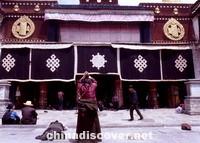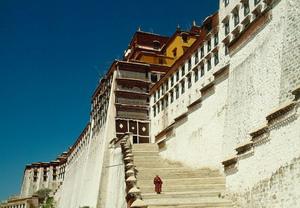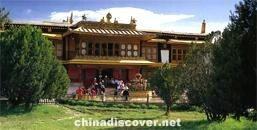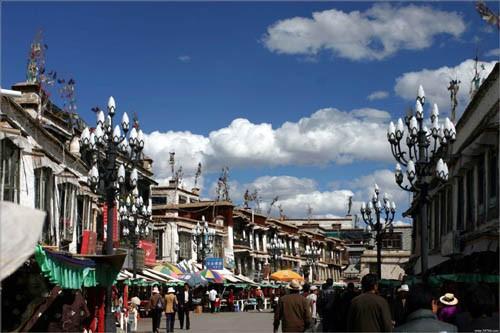
Overview
Located in the center of the ancient city of Lhasa, the Jokhang Monastery was built in the seventh century by Songtsan Gambo, the Tang Princess Wen Cheng and Nepalese Princess Bhrikuti. Its four story main building demonstrates a combination of the Han, Tibetan, Indian and Nepalese architectural styles, as well as a man - made world outlook of Buddhism. With the Hall of Amitayus Sutra as its center, the monastery symbolizes the nuclear to the universe. The Hall of Sakyamuni is the essence of the monastery.
Know more
Jokhang is the spiritual center of Tibet, the Holy of Holies, the destination of millions of Tibetan pilgrims. Unlike the lofty Potala, the Jokhang has intimate, human proportions, bustling with worshippers and redolent with mystery. The outer courtyard and porch of the Jokhang Monastery are usually filled with pilgrims making full-length prostration towards the holy sanctum. Its innermost shrine contains the oldest, most precious object in Tibet - the original gold stature of Sakyamuni - the historical Buddha, which Princess Wen Cheng brought from Chang'an 1,300 years ago.
It was said that Nepal Princess Tritsun decided to build a temple to house the Jowo Sakyamuni aged 12 brought by Chinese Princess Wencheng. Princess Wencheng reckoned according to Chinese astrology that the temple should be built on the pool where the Jokhang now locates. She contended that the pool was a witch's heart, so the temple should be built on the pool to get rid of evils.
The pool still exists under the temple. Then goats were used as the main pack animals, as is the reason the city is called Lhasa. The construction took 12 months. However it was originally small and had been expanded to today's scale in later dynasties. When the Fifth Dalai Lama took reign, large-scale reconstruction and renovation had been done.
The temple is a combination of Han, Tibetan and Nepalese architectural techniques. Visitors will see sphinx and other sacred sculptures.
Every year, the Great Prayer Festival will be held in the Temple. The rites of Dalai Lamas and Panchen Lamas' initiation into lamahood are also held in the monastery.
Must see
Potala Palace

Over 1,300 years old, Lhasa dates back to th 7th century A.D when the colorful Tibetan figure, Songtsen Gampo, built his palace in Lhasa. In 1642, the 5th Dalai Lama also made Lhasa his capital and rebuilt the architectural wonder, the Potala Palace, on top of the ruins of Songtsen's old abode. Today the Potala Palace contines to dominate the Lhasa skyline and is the most visible of all of the city's sights. It offers one of the best views of Lhasa and the surrounding area, especially in the early...more
Norbu Lingka

It was Built in 1751 as the summer residerce of the Dalai Lama, lies 3km west of the Potala Palace. As harsh winters gave way to spring, a grand procession of Lama and officials accompanied the Dalai Lama from the Potala Palace to his summer home. Norbu Lingka, which means" jeweled garden," is a fitting title for the large compound of buildings and extensive gardens. The palace contains soem fabulous murals fusing Tibetan history and myth. Some of the finest murals are found at the back of the woods in the Golden Lingka and Chensal Potrang...more
Bakhor Street

One of the best places to view modern day Lhasa and its diversity of culture is in the bustling Barkhor Street, a section of the old city. Here, the Barkhor Market has all manner of goods from turquoise jewelry to meditation beads, colorful traditional Tibetan clothes and yak wool sweaters. Here you can watch groups of monks draped in their maroon and saffron robes mingling with Tibetans from remote areas wearing long boots, sporting daggers and large turquoise necklaces...more
Related News
Photos
More>>history
Traditions
- Guests from SISU Visit
- SCUT holds opening ceremony for 2008 graduate students of professional degrees
- Architectural Design Institute receives important architectural awards
- HU Jintao receives HE Jingtang and other constructers of China pavilion of World
- President LI Yuanyuan and Academician HE Jingtang attend the Groundbreaking
arts
- Press conference held for interpretation of SCUT's elements in 2010 Shanghai
- Over a thousand of students for professional degrees enroll in SCUT
- Academician HE Jingtang awarded International Lifetime Achievement Award of
- China Pavilion for Shanghai World Expo 2010 book series newly released
- SCUT students win Silver Prize in the 8th China Environmental Art Design Prize





